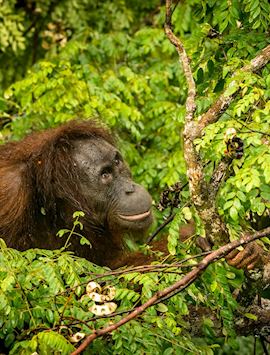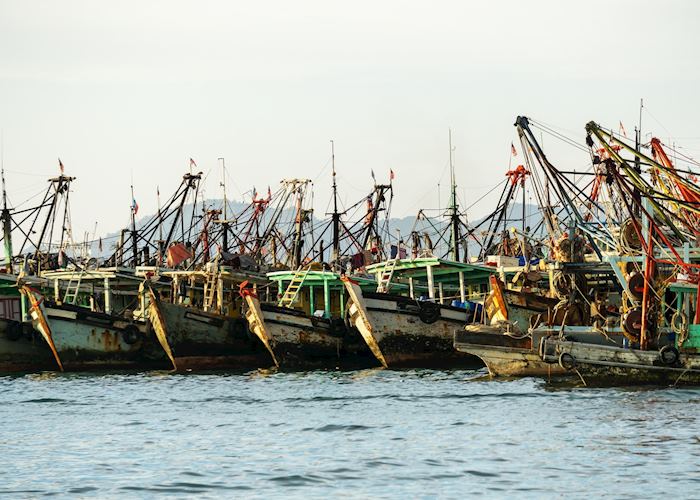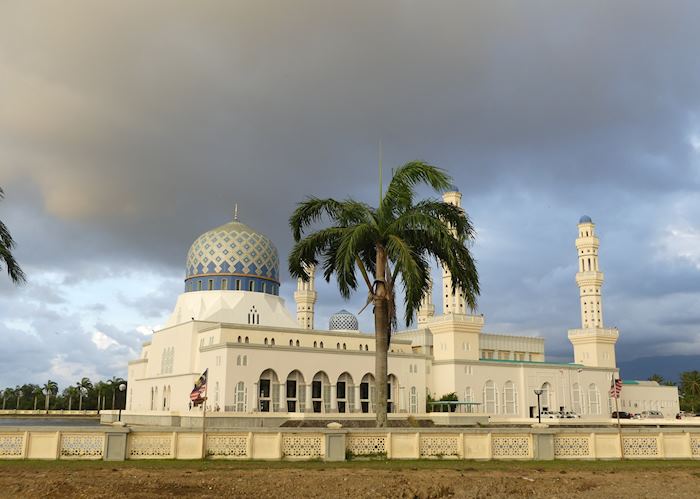Jump to:
Kota Kinabalu’s busy fishing port, rows of street stalls and gleaming shopping malls can be quite the contrast to Borneo’s natural attractions. Better known as KK, the city is the capital of Sabah state and, with one of the island’s few airports, the most popular gateway into Malaysian Borneo. It can be tempting to whisk yourself straight off to the wilds, but linger and you’ll get a taste of the local cooking, and you’ll hear the story of a city that had to pull itself from the ashes after World War II.
 Even if you stay in Kota Kinabalu just one night, you’ll have time to visit the pasar malam (night market) along the waterfront. Sea bream, red snappers, shellfish and lobsters, caught that morning, are laid out in neat rows under a haze of grill smoke for customers to choose. Your dish is cooked fresh in front of you and often presented on a stick or atop a pile of steaming noodles.
Even if you stay in Kota Kinabalu just one night, you’ll have time to visit the pasar malam (night market) along the waterfront. Sea bream, red snappers, shellfish and lobsters, caught that morning, are laid out in neat rows under a haze of grill smoke for customers to choose. Your dish is cooked fresh in front of you and often presented on a stick or atop a pile of steaming noodles.
If fish isn’t your penchant, you’ll also find a range of Malay, Indonesian, Filipino and Chinese dishes, representing the communities who’ve migrated to the city. Look out for tuaran mee, a Sabah specialty of curly egg noodles topped with barbecued pork slices, egg and sweet rice wine — it has quite a twang.
Walk (although, if you’re there around 7pm, expect more of a shuffle) through to the market’s southern end, where fresh fruit and vegetables, fish paste, and dried fish are piled up under the naked bulbs. You can also peruse a range of handicrafts from across Borneo, Indonesia and the Philippines — particularly pearl items and beaded jewellery.
To delve further into Sabah’s cuisine, you can take a guided market tour with a local gastronome, who’ll talk you through some of the more niche local ingredients, including latok, a seaweed that resembles bright-green caviar. Cooking courses can also be arranged to help you prepare your own dishes.
The central city is explored by foot in a few hours, although the knowledge of an experienced guide might come in helpful. The city was almost completely destroyed during the Japanese invasion in 1942. The wooden-slatted early 20th-century colonial post office is one of the few buildings to remain, now used as Sabah Tourism’s office.
Walk past the markets and glaringly-lit shopping malls to Jettison Point and you’ll see the port busy with fishing boats and brightly painted vessels offering cruises to Gaya Island, just across the water. A thickly forested island, Gaya shelters Tunku Abdul Rahman Park, a flourishing marine enclave of coral, giant clams and shoals of dazzling fish. Although you can make an outing for the day from Kota Kinabalu, you’re best to visit the park while staying at one of the island’s beach resorts.
A smattering of small villages and plantations surround the city, and you can explore them by bicycle along a series of narrow roads and dirt tracks. Cycling through the rural village of Kiulu, you’ll see rubber plantations, fruit orchards and paddy fields, as well as Malay-style houses built on stilts that slot into the hills.
A couple of hours inland is the Crocker Range National Park, a forest reserve that separates Kota Kinabalu and the coastal plains from the rest of Sabah. The rafflesia, the world’s largest flower, is the jewel of its flora, alongside orchids and pitcher plants. You’ll need a guide to lead you, as the paths fan out in an unmarked web through the forests, skirting along, over and through the Padas River.
 Kinabalu National Park, a two-hour drive away, is dominated by a sheer-sided peak that looks like it only recently emerged from the Earth’s crust. The people of Sabah are so proud of Mount Kinabalu, Borneo’s highest peak, that it’s on their flag. If you’d like to take on the challenging climb to the summit, you’ll need a permit, a guide and to arrange your trip at least a year in advance.
Kinabalu National Park, a two-hour drive away, is dominated by a sheer-sided peak that looks like it only recently emerged from the Earth’s crust. The people of Sabah are so proud of Mount Kinabalu, Borneo’s highest peak, that it’s on their flag. If you’d like to take on the challenging climb to the summit, you’ll need a permit, a guide and to arrange your trip at least a year in advance.
Otherwise, you can hike in the peak’s shadow. You have the option to visit for the day from Kota Kinabalu or, to explore fully, spend a night or two in the park.
One of Borneo’s (and the world’s) most important biological sites, the park grants you a lengthy list of birds and flora to spot (including the rafflesia). But, watch where you tread, because it also boasts more than 100 varieties of snail.
Best time to visit Kota Kinabalu
On an island once covered in rainforest, dry is a relative term — be prepared for tropical showers at any point. But, generally, the best time to go to Kota Kinabalu is from July to September, when the rainfall is at its lowest.
The heaviest rains tend to fall from October to March. Temperatures remain at around 25°C (77°F) year-round, but you’ll need layers for hiking (at the peak of Mount Kinabalu, it can dip below freezing point).
who's been there
-
01993 838 92501993 838 120
- Make an enquiry
Suggested itineraries featuring Kota Kinabalu
Our itineraries will give you suggestions for what is possible when you travel in Kota Kinabalu, and they showcase routes we know work particularly well. Treat them as inspiration, because your trip will be created uniquely by one of our specialists.
Places near Kota Kinabalu
- Gaya Island 7 miles away
- Manukan Island 8 miles away
- Kinabalu National Park 31 miles away
- Mount Kinabalu 32 miles away
- Garama Wetlands 90 miles away
- Deramakot Forest Reserve 100 miles away
- Brunei 108 miles away
- Maliau Basin 112 miles away
- Sepilok 127 miles away
- Kinabatangan River 128 miles away
- Sandakan 134 miles away
- Danum Valley 141 miles away
- Mulu National Park 156 miles away
- Miri, Niah Caves & Lambir Hills National Park 186 miles away
- Tabin Wildlife Reserve 188 miles away
Photos of Kota Kinabalu
Accommodation choices for Kota Kinabalu
We've selected a range of accommodation options for when you visit Kota Kinabalu. Our choices usually come recommended for their character, facilities and service or location. Our specialists always aim to suggest properties that match your preferences.
-
![Aerial View, Shangri-La's Rasa Ria Resort & Spa, Kota Kinabalu]()
Shangri-La's Rasa Ria Resort & Spa
Kota Kinabalu
Ideas for experiencing Kota Kinabalu
Our specialists seek out authentic ways to get to know the places that could feature in your trip. These activities reflect some of the experiences they've most enjoyed while visiting Kota Kinabalu, and which use the best local guides.
-
North Borneo steam locomotive day trip ![North Borneo Railway excursion]()
North Borneo steam locomotive day trip
North Borneo steam locomotive day trip
Enjoy the unique sights and sounds of local villages, paddy fields, mangrove jungle and pristine coastal beaches as you while away a leisurely day in comfort.
View details -
The Orangutan Sanctuary at Sepilok ![Baby orangutan at the Sanctuary]()
The Orangutan Sanctuary at Sepilok
The Orangutan Sanctuary at Sepilok
The centre rehabilitates orphaned orangutans and those that have been held in captivity. It's set amidst dense jungle and you can take a walk into the jungle to see them in their natural environment.
View details
















